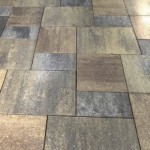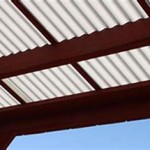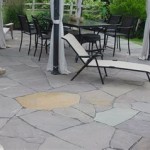Patio Concrete Ideas: Enhancing Outdoor Living Spaces
Concrete, once relegated to purely utilitarian applications, has emerged as a versatile and aesthetically pleasing material for outdoor living spaces, particularly patios. Its durability, affordability, and malleability allow for a wide range of design possibilities, making it an ideal choice for homeowners seeking to create functional and visually appealing outdoor environments. From simple, poured slabs to intricately stamped and stained surfaces, concrete patios offer a canvas for personalized expression and enhanced outdoor enjoyment.
This versatility extends to various architectural styles, seamlessly integrating with modern minimalist designs, rustic farmhouse aesthetics, and everything in between. Concrete's inherent strength withstands the elements, resisting wear and tear from weather fluctuations, heavy foot traffic, and outdoor furniture. Its relatively low maintenance requirements further contribute to its appeal, requiring minimal upkeep compared to alternative patio materials such as wood or natural stone. This exposition will explore various patio concrete ideas, focusing on design considerations, finishing techniques, and practical applications for creating stunning outdoor spaces.
Exploring Design Considerations for Concrete Patios
The design process for a concrete patio should begin with a thorough assessment of the existing landscape, architectural style, and intended use of the space. Understanding these fundamental aspects will inform crucial decisions regarding the patio's size, shape, color, texture, and overall aesthetic. A well-designed patio should not only complement the surrounding environment but also enhance its functionality and visual appeal.
The size of the patio should be proportionate to the overall size of the property and the scale of the house. A patio that is too small may feel cramped and limiting, while one that is excessively large may appear disproportionate and overwhelming. The intended use of the patio will also influence its size. For example, a patio designed for outdoor dining and entertaining will require more space than one intended solely for relaxation and lounging.
The shape of the patio can significantly impact its visual appeal and functionality. While rectangular or square patios are common and practical, incorporating curves, angles, or irregular shapes can add visual interest and create a more dynamic space. Consider the flow of traffic and the placement of furniture when determining the shape of the patio. Avoid sharp corners or narrow passageways that may impede movement or create uncomfortable spaces.
Color plays a crucial role in defining the aesthetic of the patio. Concrete can be tinted to achieve a wide range of hues, from natural grays and browns to vibrant reds, blues, and greens. The color of the patio should complement the surrounding landscape and architectural style. Lighter colors can create a brighter and more open feel, while darker colors can add warmth and sophistication. Consider the impact of sunlight exposure on the color of the patio. Darker colors may absorb more heat, making them uncomfortable in direct sunlight.
Texture adds another layer of visual interest and tactile appeal to concrete patios. Various finishing techniques, such as brooming, stamping, and texturing, can create a wide range of surface textures. Broom-finished concrete provides a subtle, slip-resistant surface, while stamped concrete can mimic the appearance of natural stone, brick, or tile. Textured concrete can be achieved through the use of specialized tools and techniques, creating unique and visually appealing patterns.
Furthermore, incorporating elements such as built-in seating, fire pits, water features, and planters can enhance the functionality and aesthetic appeal of a concrete patio. These elements can create focal points, define distinct areas within the patio, and add a touch of personality and character. Consider integrating lighting into the patio design to extend its usability into the evening hours. Strategically placed lighting can create a warm and inviting ambiance, enhance safety, and highlight architectural features.
Exploring Finishing Techniques for Concrete Patios
The finishing technique applied to a concrete patio can dramatically alter its appearance and performance. Selecting the appropriate finishing technique is crucial for achieving the desired aesthetic and ensuring the patio's durability and longevity. Several popular finishing techniques are available, each offering unique advantages and disadvantages.
Broom-finished concrete is a common and cost-effective option, providing a subtle, slip-resistant surface. This technique involves dragging a broom across the surface of the concrete while it is still wet, creating a textured finish. The direction and coarseness of the broom can be varied to achieve different aesthetic effects. Broom-finished concrete is a practical choice for patios that will be subjected to heavy foot traffic or slippery conditions.
Stamped concrete involves imprinting patterns into the surface of the concrete while it is still wet using specialized stamps. A wide range of patterns is available, mimicking the appearance of natural stone, brick, tile, and other materials. Stamped concrete can add visual interest and sophistication to a patio, creating a more upscale and luxurious look. The cost of stamped concrete is generally higher than broom-finished concrete due to the specialized tools and techniques required.
Exposed aggregate concrete involves removing the top layer of cement paste to reveal the aggregate beneath. This technique can create a visually appealing and textured surface, showcasing the natural beauty of the aggregate. The type and size of the aggregate can be chosen to achieve different aesthetic effects. Exposed aggregate concrete is a durable and slip-resistant option, making it suitable for patios that will be subjected to heavy use.
Polished concrete involves grinding and polishing the surface of the concrete to create a smooth, glossy finish. This technique can enhance the natural beauty of the concrete and create a sophisticated and modern look. Polished concrete is a durable and low-maintenance option, but it can be slippery when wet. To mitigate this, non-slip additives can be incorporated. Polished concrete suitable for patios typically involves an exterior-grade sealant for weather resistance.
Stained concrete involves applying a stain to the surface of the concrete to add color and enhance its appearance. A wide range of stain colors is available, allowing for a high degree of customization. Stained concrete can be used to create a variety of aesthetic effects, from natural and earthy tones to vibrant and bold colors. The application process requires careful surface preparation and expertise to ensure a consistent and even color distribution. Stain selection is paramount; exterior grade stains are essential for longevity and UV resistance.
Practical Applications and Maintenance of Concrete Patios
Beyond aesthetics, a well-constructed concrete patio provides numerous practical benefits. Its durability withstands harsh weather conditions and heavy use, offering a long-lasting and reliable outdoor space. Proper maintenance is essential for preserving its integrity and appearance, and ensuring years of enjoyment.
A concrete patio serves as an ideal foundation for outdoor dining and entertaining. Its smooth and level surface provides a stable platform for tables, chairs, and other furniture. The size and shape of the patio can be customized to accommodate various seating arrangements and dining configurations. Integrating built-in seating or a designated dining area can further enhance the functionality of the patio.
Concrete patios can also create comfortable and inviting outdoor living spaces. Adding comfortable seating, outdoor rugs, and shade structures can transform a patio into a relaxing oasis. Consider incorporating elements such as fire pits, water features, and planters to create a more inviting and aesthetically pleasing environment. A well-designed patio can extend the living space of a home, providing a seamless transition between indoors and outdoors.
The inherent durability of concrete makes it an excellent choice for high-traffic areas. Its resistance to wear and tear ensures that the patio will withstand years of use without significant deterioration. Properly installed and maintained concrete patios can last for decades, providing a long-term investment in the property's value and enjoyment.
Maintenance of a concrete patio is relatively straightforward, requiring minimal effort to keep it looking its best. Regular cleaning with a mild soap and water solution removes dirt, debris, and stains. Pressure washing can be used to remove stubborn stains and mildew, but caution should be exercised to avoid damaging the surface of the concrete. Sealing the concrete patio with a quality sealant helps to protect it from moisture, stains, and UV damage. Sealants should be reapplied periodically, typically every one to two years, depending on the type of sealant and the level of exposure to the elements.
Addressing cracks promptly is crucial for preventing further damage. Small cracks can be repaired with patching compounds, while larger cracks may require professional attention. Proper drainage is essential for preventing water damage and prolonging the lifespan of the patio. Ensure that the patio is properly sloped to allow water to drain away from the house and prevent ponding. Additionally, avoid using de-icing salts on concrete patios, as they can damage the surface and cause it to deteriorate over time. Use sand or other non-corrosive alternatives to provide traction during icy conditions.
In conclusion, concrete offers an array of possibilities for transforming outdoor spaces. From design considerations to diverse finishing techniques and practical uses, understanding the nuances of concrete patios enables homeowners to create beautiful, functional, and enduring outdoor living environments. With careful planning, expert execution, and diligent maintenance, a concrete patio can become a valued asset, enhancing the property's aesthetic appeal and providing years of enjoyment for family and friends.

Concrete Patio Ideas Design Your Backyard Network

Concrete Patio Design Ideas And Cost Landscaping Network

20 Design Ideas For Your Concrete Patio

9 Fresh Concrete Patio Ideas For Yards Of All Styles

Backyard Stained And Stamped Concrete Patios

Concrete Patio Ideas To Dress Up A Drab Space Bob Vila

9 Fresh Concrete Patio Ideas For Yards Of All Styles

7 Concrete Patio Design Ideas To Enhance Your Home

Concrete Patio Design Ideas And Cost Landscaping Network

Concrete Patio Ideas For The Summer Bergen Mobile
Related Posts








